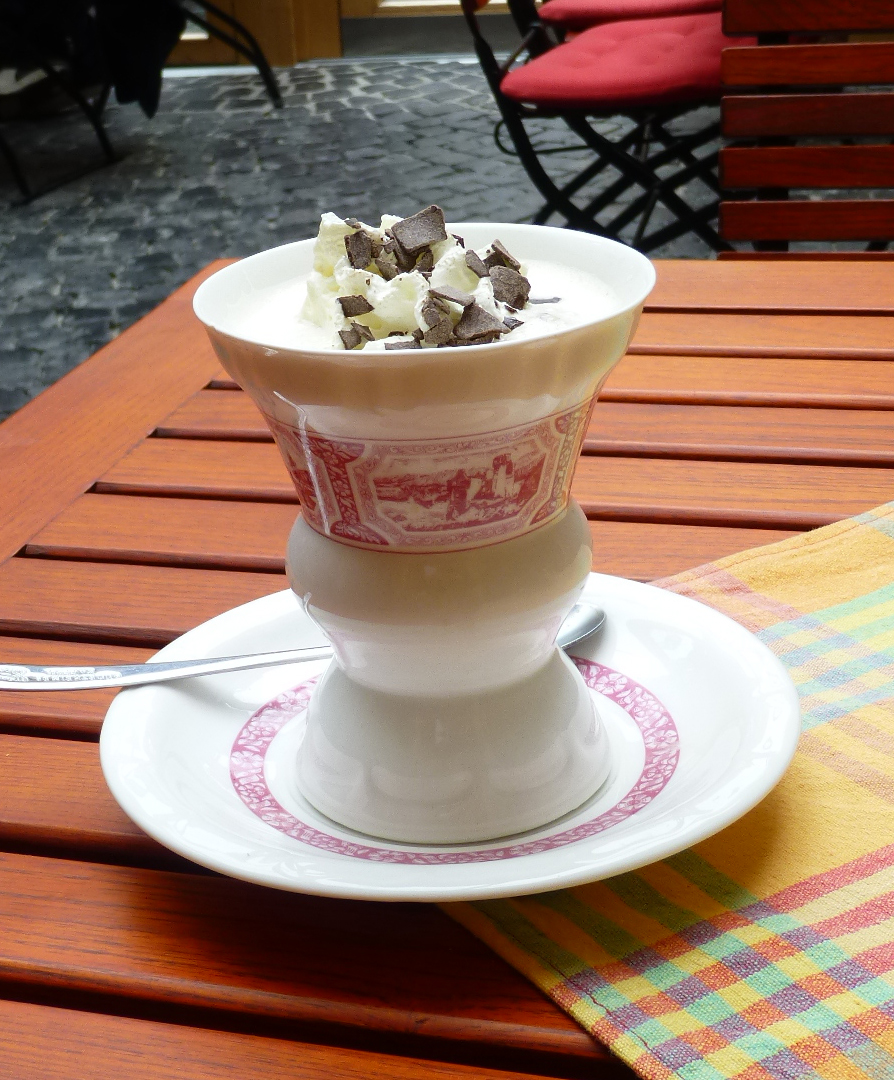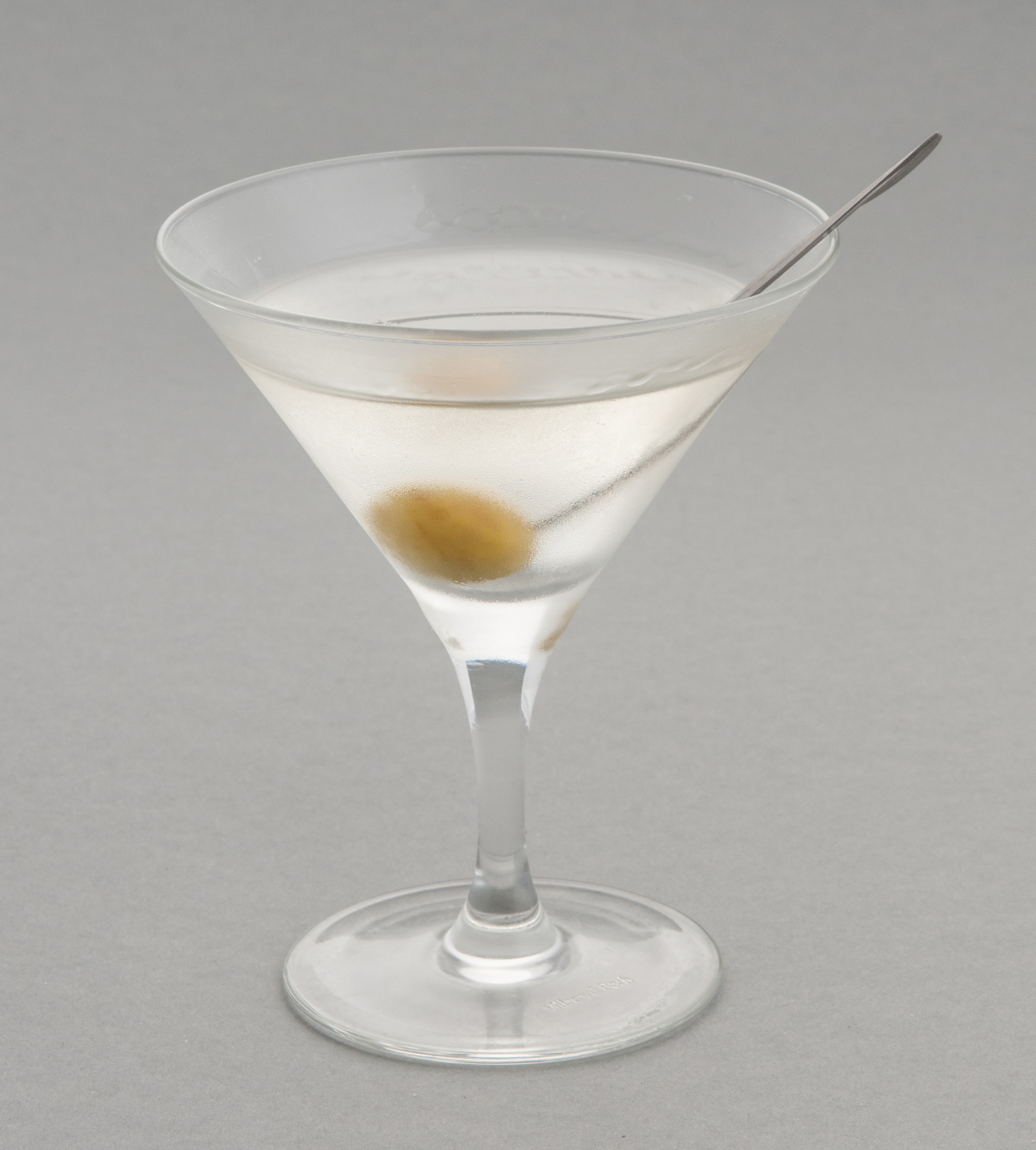|
Rüdesheimer Kaffee
Rüdesheimer Kaffee is an alcoholic coffee drink from Rüdesheim am Rhein in Germany invented in 1957 by the German television chef, . It is a popular drink in coffee houses. Asbach Uralt brandy and sugar cubes are added to a cup. In Rüdesheim, a cup that is specially designed for this beverage is used. The brandy is flambéed and stirred for a minute until the sugar dissolves. Strong coffee is added, followed by a topping of thickly whipped cream sweetened with vanilla sugar. Chocolate flakes are scattered onto the cream as a garnish. Travels and Traditions, 2008. 
See also * |
Asbach Uralt
Asbach Uralt is a German brandy produced by the company Asbach GmbH, a subsidiary of Underberg AG, which also makes other spirits and chocolate. Its history dates back to 1892 when Hugo Asbach (1868–1935) founded the company in the town of Rüdesheim am Rhein. Asbach, a native from Cologne, learned the distillery trade at the local "Export-Company for German Cognac" and further improved his knowledge in France. He founded his own company on 11 May 1892, distributing domestic "Rüdesheim Cognac" which soon became popular. After World War I, when the Treaty of Versailles decreed that the word ''Cognac'' could only be used for French products, Hugo Asbach coined the term ''Weinbrand'' for German brandy, which in 1923 became an official classification according to German wine law. From 1924, Asbach also distributed brandy filled pralines ("brandy beans") to address new customer demographics. The coffee drink Rüdesheimer Kaffee, invented in 1957, contains Asbach as its alcoholic ... [...More Info...] [...Related Items...] OR: [Wikipedia] [Google] [Baidu] |
Rüdesheim Am Rhein
Rüdesheim am Rhein is a German winemaking town in the Rhine Gorge, and part of the UNESCO World Heritage Site in this region. It lies in the Rheingau-Taunus-Kreis district in the ''Regierungsbezirk'' of Darmstadt, Hessen. Known as Rüdesheim, it is officially Rüdesheim am Rhein, to distinguish it from Rüdesheim an der Nahe. It is a major tourist attraction, especially for foreign visitors. Geography Location Rüdesheim lies at the foot of the Niederwald on the Rhine's right bank in the Rheingau wine region. The town belongs to the Frankfurt Rhine Main Region and to the World Heritage Site Rhine Gorge. It has a picturesque Old Town, located in the Rheingau landscape celebrated in Rhine romanticism. Territorial structure Rüdesheim am Rhein as a municipality consists of five quarters: * Rüdesheim am Rhein (initial part and center) * Eibingen including Windeck, Eibingen Abbey and Nothgottes * Assmannshausen * Aulhausen including the former and * Presberg Ass ... [...More Info...] [...Related Items...] OR: [Wikipedia] [Google] [Baidu] |
Germany
Germany,, officially the Federal Republic of Germany, is a country in Central Europe. It is the second most populous country in Europe after Russia, and the most populous member state of the European Union. Germany is situated between the Baltic and North seas to the north, and the Alps to the south; it covers an area of , with a population of almost 84 million within its 16 constituent states. Germany borders Denmark to the north, Poland and the Czech Republic to the east, Austria and Switzerland to the south, and France, Luxembourg, Belgium, and the Netherlands to the west. The nation's capital and most populous city is Berlin and its financial centre is Frankfurt; the largest urban area is the Ruhr. Various Germanic tribes have inhabited the northern parts of modern Germany since classical antiquity. A region named Germania was documented before AD 100. In 962, the Kingdom of Germany formed the bulk of the Holy Roman Empire. During the 16th ce ... [...More Info...] [...Related Items...] OR: [Wikipedia] [Google] [Baidu] |
Sugar Cube
Sugar is the generic name for sweet-tasting, soluble carbohydrates, many of which are used in food. Simple sugars, also called monosaccharides, include glucose, fructose, and galactose. Compound sugars, also called disaccharides or double sugars, are molecules made of two bonded monosaccharides; common examples are sucrose (glucose + fructose), lactose (glucose + galactose), and maltose (two molecules of glucose). White sugar is a refined form of sucrose. In the body, compound sugars are hydrolysed into simple sugars. Longer chains of monosaccharides (>2) are not regarded as sugars, and are called oligosaccharides or polysaccharides. Starch is a glucose polymer found in plants, the most abundant source of energy in human food. Some other chemical substances, such as glycerol and sugar alcohols, may have a sweet taste, but are not classified as sugar. Sugars are found in the tissues of most plants. Honey and fruits are abundant natural sources of simple sugars. Suc ... [...More Info...] [...Related Items...] OR: [Wikipedia] [Google] [Baidu] |
Flambé
:''Flambé is also a type of ceramic glaze.'' Flambé (, , ; also spelled flambe) is a cooking procedure in which alcohol is added to a hot pan to create a burst of flames. The word means "flamed" in French. Flambéing is often associated with the tableside presentation of certain liqueur-drenched dishes set aflame, such as Bananas Foster or Cherries Jubilee when the alcohol is ignited and results in a flare of blue-tinged flame. However, flambéing is also a step in the making coq au vin, and other dishes and sauces, using spirits before they are brought to the table. By partially burning off the volatile alcohol, flambéing reduces the alcoholic content of the dish while keeping the flavors of the liquor. History Modern flambéing became popular in the 19th century. The English Christmas pudding was served flaming in Charles Dickens' 1843 novel, ''A Christmas Carol'': "the pudding... blazing in half of half-a-quarter of ignited brandy". The most common flambé dish appears to h ... [...More Info...] [...Related Items...] OR: [Wikipedia] [Google] [Baidu] |
Vanilla Sugar
Vanilla sugar (German: ''Vanillezucker'', Polish: ''Cukier waniliowy'', Hungarian: ''Vaníliás cukor'', Swedish: ''Vaniljsocker'', Macedonian: ''Ванилин шеќер'') is a commonly used ingredient of Italian, Dutch, German, Polish, Swedish, Finnish, Danish, Austrian, Norwegian, Hungarian, Czech, Slovak, Slovenian, Croatian, Bosnian, Serbian, Turkish and other European desserts. Vanilla sugar is made of sugar and vanilla beans, or sugar mixed with vanilla extract (in a proportion of two cups of sugar for one teaspoon of extract). Pre-packaged vanilla sugar can be costly and difficult to obtain outside Europe but can be made at home. Sometimes it can be replaced with vanilla extract, where one teaspoon equals one package. However, when it is needed as a topping, vanilla extract is unsuitable. Vanilla sugar can be prepared by combining 400 g (2 cups) of white sugar with the scraped seeds of one vanilla bean. It can also be made by adding 1 to 2 whole vanilla beans t ... [...More Info...] [...Related Items...] OR: [Wikipedia] [Google] [Baidu] |
Chocolate Flake
Flake is a British brand of chocolate bar currently manufactured by British chocolate company Cadbury consisting of thinly folded milk chocolate. The bar has a unique crumbly texture, and softens but does not melt when heated. History The original Flake product was first developed in 1920 and was discovered by chance by an employee of Cadbury's at the Bournville factory who noticed thin streams of excess chocolate falling from moulds cooled into flaky ripples. By 1930, Cadbury's was selling half-length Flake specifically for prodding into vanilla soft serve ice cream in a cone (" 99 Flakes") which was served by ice cream vendors. First sold in the UK, they would later be sold in Ireland, Australia, South Africa and other nations. The later product, Cadbury Twirl, has two Flake-style bars covered in milk chocolate. Flakes are no longer manufactured at Bournville and are now made in Dublin Ireland, and 10th of Ramadan, Egypt. Manufacturing process Cadbury refers to the exa ... [...More Info...] [...Related Items...] OR: [Wikipedia] [Google] [Baidu] |
Irish Coffee
Irish coffee ( ga, caife Gaelach) is a caffeinated alcoholic drink consisting of Irish whiskey, hot coffee and sugar, which has been stirred and topped with cream (sometimes cream liqueur). The coffee is drunk through the cream. Origin Different variations of coffee cocktails pre-date the now-classic Irish coffee by at least 100 years. From the mid-19th century, the ''Pharisäer'' and the ''Fiaker'' were served in Viennese coffee houses; both were coffee cocktails served in glass, topped with whipped cream. The former was also known in northern Germany and Denmark around that time. Around 1900, the coffee cocktail menu in the Viennese cafés also included ''Kaisermelange'', ''Maria Theresia'', ''Biedermeier-Kaffee'' and a handful of other variations on the theme. In 19th-century France, a mixture of coffee and spirits was called a ''gloria''. * "" (Balzac, ''Le Père Goriot'', 1834, I.) * "" (Flaubert, ''Madame Bovary'', 1857.) Several places claim to have developed the mod ... [...More Info...] [...Related Items...] OR: [Wikipedia] [Google] [Baidu] |
List Of Coffee Beverages
Coffee drinks are made by brewing water with ground coffee beans. The brewing is either done slowly by drip, filter, French press, ''cafetière'' or percolator, or done very quickly under pressure by an espresso machine. When put under the pressure of an espresso machine, the coffee is termed ''espresso'' while slow-brewed coffees are generally termed ''brewed coffee.'' While all coffee drinks are based on either coffee or espresso, some drinks add milk or cream, some are made with steamed milk or non-dairy milks, or add water (like the ''americano).'' Upon milk additions, coffee's flavor can vary with different syrups or sweeteners, alcoholic liqueurs, and even combinations of coffee with espresso or tea. There are many variations to the basic coffee or espresso bases. With the invention of the Gaggia machine, espresso, and espresso with milk such as cappuccino and latte, spread in popularity from Italy to the UK in the 1950s. It then came to America, and with the rise in p ... [...More Info...] [...Related Items...] OR: [Wikipedia] [Google] [Baidu] |
Alcoholic Coffee Drinks
Alcoholism is, broadly, any drinking of alcohol that results in significant mental or physical health problems. Because there is disagreement on the definition of the word ''alcoholism'', it is not a recognized diagnostic entity. Predominant diagnostic classifications are alcohol use disorder (DSM-5) or alcohol dependence (ICD-11); these are defined in their respective sources. Excessive alcohol use can damage all organ systems, but it particularly affects the brain, heart, liver, pancreas and immune system. Alcoholism can result in mental illness, delirium tremens, Wernicke–Korsakoff syndrome, irregular heartbeat, an impaired immune response, liver cirrhosis and increased cancer risk. Drinking during pregnancy can result in fetal alcohol spectrum disorders. Women are generally more sensitive than men to the harmful effects of alcohol, primarily due to their smaller body weight, lower capacity to metabolize alcohol, and higher proportion of body fat. In a small num ... [...More Info...] [...Related Items...] OR: [Wikipedia] [Google] [Baidu] |
Cocktails With Brandy
A cocktail is an alcoholic mixed drink. Most commonly, cocktails are either a combination of spirits, or one or more spirits mixed with other ingredients such as tonic water, fruit juice, flavored syrup, or cream. Cocktails vary widely across regions of the world, and many websites publish both original recipes and their own interpretations of older and more famous cocktails. History The origins of the word ''cocktail'' have been debated (see section Etymology). The first written mention of ''cocktail'' as a beverage appeared in ''The Farmers Cabinet,'' 1803 in the United States. The first definition of a cocktail as an alcoholic beverage appeared three years later in ''The Balance and Columbian Repository'' (Hudson, New York) May 13, 1806. Traditionally, cocktail ingredients included spirits, sugar, water and bitters, however, this definition evolved throughout the 1800s, to include the addition of a liqueur. In 1862 Jerry Thomas published a bartenders: guide called ''How ... [...More Info...] [...Related Items...] OR: [Wikipedia] [Google] [Baidu] |







